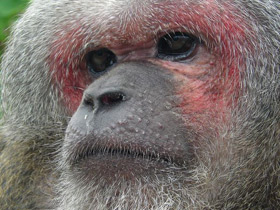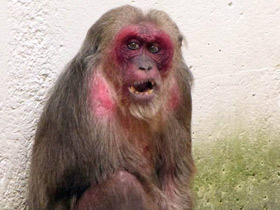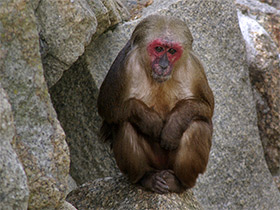The stump-tailed macaque (Macaca arctoides), the bear macaque
The stub-tailed macaque (Macaca arctoides), also called the bear macaque, is a species of macaque native to southern and south-eastern Asia. In India, it lives south of the Brahmaputra River in northeast India. Its range in India extends from Assam and Meghalaya to eastern Arunachal Pradesh, Nagaland, Manipur, Mizoram and Tripura.
It is mainly frugivorous, but eats many types of vegetation such as seeds, leaves and roots, but also hunts freshwater crabs, frogs, bird eggs and insects.
Habitat
Macaca arctoides is a species of catarrhine primate of the family Cercopithecidae.
Macaca arctoides is widespread in southern and southeastern Asia. Its range includes southern China, India, Burma, western Malaysia, Thailand, Vietnam, Bangladesh and the Malay Peninsula, with a small introduced population also residing on the island of Tanahpillo in Mexico. These macaques inhabit subtropical evergreen forests up to 1,500 m altitude and tropical evergreen forests at altitudes of 1,800-2,500 m.
Appearance
The coat of Macaca arctoides is thick, dark brown; the face is hairless, with red skin; the tail is also hairless, short, 32-70 mm long. Macaca arctoides hatchlings are born with white fur, but this darkens over time. The species is sexually dimorphic: males are larger and weigh between 9.9 and 10.2 kg with a body length ranging from 517 to 650 mm, females weigh between 7.5 and 9.1 kg with a body length ranging from 485 to 585 mm. In addition, the canines of male Macaca arctoides are significantly longer than those of females.
Social behaviour
Macaca arctoides are kept in large groups of up to 60 animals, in which a strict hierarchy is observed. Each group covers an area of several square kilometres. Females remain in the group as adults, females leave the group.
Behaviour and ecology
Stub-tailed macaques generally share the same social structure as any other macaque species, with a linear dominance hierarchy that is rigid and hereditary in females and fluctuates among males depending on their fighting and social manoeuvring abilities, but what makes the stub-tailed macaques truly unique is their ability to defuse intense confrontations and maintain a high degree of pacifism and harmony in their troop, thanks to their surprisingly rich repertoire of reconciliation tactics. This species has no lasting pair bonds and is truly promiscuous, a staple for macaques. Physical violence is very rare, and although small fights and displays of physical intimidation often occur, they tend to be resolved quickly, which is why this species is described as peaceful. Stub-tailed macaques are very undemanding in their feeding habits, although fruit is often a staple of their nutrition. Stub-tailed macaques have a large, bulky and muscular build, with thick, solid limbs, making them very mobile on the ground but rather ungainly in the trees, and this unusual physique for a macaque may be responsible for the unique tendency of this species to consume greater quantities of meat than other macaque species. They feed on large quantities of insects, small animals and eggs.
Lifestyle and nutrition
Macaques live on the ground and move on four limbs. They are omnivores, but prefer to eat fruit; seeds, flowers, roots, leaves and small animals supplement their diet. Foraging usually takes place in the morning before noon.
Reproduction
Elevated levels of sex steroid hormones, specifically 17β-estradiol and progesterone, were observed in a study population of female stub-tailed macaques. Levels of 17β-estradiol were significantly higher during summer and autumn, and progesterone levels were significantly higher during summer, autumn and winter. This explains why stub-tailed macaques have two mating seasons per year: one in summer (July-August) and one in autumn (November). This is corroborated by the distribution of birth frequency in the stub-tailed macaques.
Macaca arctoides in the Red Data Book
This species is listed in the Red List of the International Union for Conservation of Nature in the "vulnerable" category. The population is most vulnerable in India, relatively stable in Thailand and declining rapidly in China and Vietnam.













































